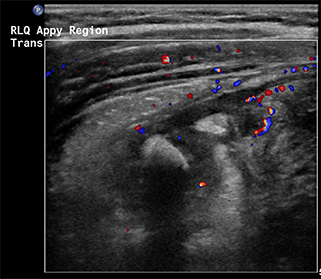Secondary signs in equivocal ultrasounds improve diagnostic accuracy of appendicitis
Secondary signs can help improve diagnosis of pediatric appendicitis when ultrasound findings are equivocal, say researchers at Emory University School of Medicine in Atlanta. This could potentially eliminate CT scans for some patients while validating them for others.

Right lower-quadrant ultrasound demonstrating multiple
secondary signs of appendicitis, including shadowing
appendicolith as well as hyperemia and increased
echogenicity of the surrounding right lower quadrant fat.
Ultrasound of the right lower quadrant (RLQ) is the American College of Radiology’s recommended initial imaging procedure for children with clinical symptoms of appendicitis. If the exam is equivocal, a CT exam may be ordered. To avoid exposing children to high doses of ionizing radiation, research studies have been undertaken to determine if laboratory test values or secondary signs seen in RLQ ultrasound can provide a more definitive diagnosis. However, most research to date has not been widely validated, according to lead Mehul V. Raval, MD, director of research and assistant professor of surgery and pediatrics in the Division of Pediatric Surgery at Children’s Healthcare of Atlanta, and colleagues.
The multispecialty team’s analysis of 530 patients with equivocal exams, published online in the Journal of Pediatric Surgery, determined that the accuracy of equivocal ultrasounds with the presence of secondary signs was more accurate than unequivocal ultrasound: up to 88.1% compared to 84.7%.
The authors evaluated the medical records of 825 patients admitted to one of two pediatric emergency departments of Children’s Healthcare of Atlanta in 2014. These patients had RLQ ultrasound to diagnose or rule out appendicitis. Two-hundred-sixty-two patients, or 32%, were ultimately found to have appendicitis.

Right lower-quadrant ultrasound (without and with
compression) demonstrating abnormal fluid collection
with increased echogenicity of the surrounding right
lower quadrant fat.
Radiologists reviewed the ultrasound exams, categorizing them as normal, positive for appendicitis, equivocal without secondary signs, or equivocal with secondary signs. Some 295 patients, or 36% of the total, had unequivocal exams, 217 of which revealed an abnormal appendix. Of this group, 83% were diagnosed with appendicitis. 530 patients had equivocal ultrasounds, and 85 showed secondary signs. Thirty-six patients, or 42% with equivocal ultrasounds showing secondary signs, were diagnosed with appendicitis. By comparison, only 8.5% of patients with equivocal ultrasounds that did not have secondary signs had appendicitis.
Secondary signs are defined as sonographic descriptions of the anatomy of structures surrounding the appendix. They include fluid collections, free fluid, echogenic fat, hyperemia, abnormal lymph nodes, bowel wall edema, abnormal adjacent bowel, and appendicoliths. The researchers determined that fluid collection, hyperemia, free fluid, and appendicolith were secondary symptoms associated with appendicitis. Equivocal ultrasounds that included hyperemia, a fluid collection, or an appendicolith had 96% specificity and 88% accuracy. Also, the presence of two secondary signs improved positive predictive value (PPV).
The authors recommend that patients with equivocal ultrasound and the presence of hyperemia, a fluid collection, or an appendicolith undergo appendectomy without additional imaging. Patients with equivocal ultrasound showing less specific secondary signs would benefit most from selective CT utilization. They believe that patients with an equivocal ultrasound but no presence of secondary signs have a very low probability of having appendicitis.
Dr. Raval told Applied Radiology that the study findings have facilitated several system-wide quality improvement efforts, such as more ubiquitous availability of ultrasound, including on nights and weekends. The department has also implemented a standardized ultrasound report that includes commentary on secondary signs. He said the preliminary results of these quality improvement efforts have demonstrated decreased CT utilization and admissions for observation of patients with equivocal ultrasounds.
REFERENCE
- Partain KN, Patel A, Travers C, et al. Secondary signs may improve the diagnostic accuracy of equivocal ultrasounds for suspected appendicitis in children.
Citation
. Secondary signs in equivocal ultrasounds improve diagnostic accuracy of appendicitis. Appl Radiol.
May 24, 2016